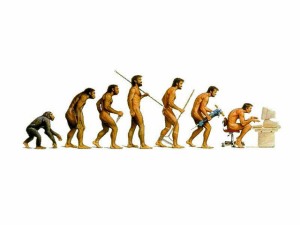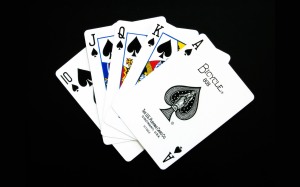What do you think of when I say “evolution”? Do you picture apes walking across your screen, gradually becoming more upright and more hairless? Do you see Darwin with his mighty beard? Do you picture a tree with nearly infinite branches, clipped and pruned, each signifying a different species, with humans at the pinnacle? Do you think of Charmander evolving into Charmeleon at level 16?
Everyone seems to have their own ideas and opinions of evolution. The thing is, science is not opinion. Certainly teachers can use their own interpretations to convey to students the essence of evolution, a scientific theory which is complex and intricate and perhaps the best explanatory force we have in our present world. But all of it is supported by evidence, reason, and independent sources.
This information is readily available to the public; nothing is hidden away or given only to those most worthy. So there’s no excuse for people to have a misunderstanding of evolution which is so blatantly incorrect and which is sometimes so far from the true that it’s as if, well, they’re making things up.
So what is evolution really saying? What evidence do we have of it occurring? How does it work?
This post will provide a very brief overview of some of the key points of evolution. Some of these will be elaborated upon in future posts. This is to give you a big picture and general understanding of what evolution means, and then later on we can work our way into the finer details and fill in those gaps. Ready?
1.) Evolution does not explain abiogenesis.
Let’s get this out of the way right off the bat. Evolution describes only the origin of species. In other words, it tells us what happened after the first living thing, probably something resembling RNA in a lipid bubble, came about in the primordial sludge or however you wish to imagine it. It does not concern itself with how inorganic molecules formed into something organic and living.
However, many of the ideas of evolution and biochemistry can be incorporated into abiogenetic studies. Dennett and Dawkins refer to this as the “crane” of evolution, where some over-arching ideas and themes can also explain geological changes and the formation of our cosmos. But this is not what scientists mean when we talk about the biological theory of evolution.
2.) Evolution is the change in gene frequencies.
The first day of my undergraduate class in Evolution involved memorizing this definition and subsequently sputtering it off in future classes as if my professor were a drill sergeant. It’s important to realize that just like the word “theory“, “evolution” has both a scientific and colloquial meaning. In every day use, evolution may just mean “change”, usually toward something bigger and better. But in biology, we must ask, “A change in what?”
That “what” is gene frequencies. For species to evolve, genes between animals must be different in order to code for different things, such as appearance or behavior. If genes were all the same, nothing would ever change and there would only be one species. Random mutations in the genetic code and different assortments of genes lead to differences in individuals, and some individuals are better equipped to survive and reproduce than others. This leads in to our next point.
3.) Evolution is not just random events.
A common argument against evolution are the words of Fred Hoyle, who compared the probability of evolution occurring to the probability of a tornado ripping through a junkyard and assembling a Boeing 747. The problem with this analogy is twofold: evolution has had billions of years to work, and evolution is not entirely random.
In very. very simple terms, evolution is like a car which relies on two things, which we can imagine like the fuel and driver. Differences in genes is the fuel which allows species to evolve. Mutations are the random events people think of, but we often forget that genes randomly assort and shuffle when we inherit genes from our parents. We’re each a little different.
Because we’re different, some of us are better at living long enough to make more offspring. Those that make it this far will pass on their genes to future generations, and those that don’t will die off along with their genes. This process is called natural selection, and it drives the direction of evolution. Natural selection is not random. We are not just rolling dice here– players that are better at a game are more likely to win than those who are not good players.
Of course, there is much more to it than this. But the main thing to take away is that there is a tug ‘o war, an almost equilibrium, which occurs between genetics and selection, between random and non-random.
4.) There is no “ladder of evolution”.
When I say that natural selection “drives the direction” of evolution, I do not want to imply that evolution has some goal that it is aiming toward. Evolution offers no foresight. There is no optimal animal that species try to become, and even if there were a pinnacle, humans would not be there.
Good mechanisms for survival evolve not because they were designed for a specific purpose, but because they gradually allowed ancestors in the past and allow individuals in the present to produce more offspring. Ultimately, every individual is a product of his or her genes, and the genes want to continue on to the next generation by whatever means necessary.
5.) Evolution implies a common ancestor of all living things.
As we look across species, we notice overwhelming similarities in anatomy, biochemical processes, cell types, and, perhaps mostly importantly, DNA. From this we can see which animals are more closely related to others and organize them into categories or a tree of life. As we gradually work backwards, we must acknowledge something quite amazing: it all had to start somewhere.
The base of the trunk on the tree of life is the common ancestor which every living thing, alive or dead or extinct, evolved from. Studies show that this was likely a primitive cell, some self-replicating molecules resembling RNA housed inside a basic layer of lipid molecules. However improbable, abiogenesis only needed to occur once. Replicating over and over, for billions and billions (Carl Sagan voice) of years, with trillions of mistakes and combinations, with differential survival by natural selection, different species arose from such simple beginnings.
6.) Evolution is supported by three main independent sources: morphology, DNA evidence, and the fossil record.
When a jury considers evidence in a court case, the strongest evidence is that which comes from different sources that agree with one another. Oral testimonies from different witnesses should line up, possibly with a few minor discrepancies, and these testimonies should agree with any physical evidence left at the scene. Additionally, lab work may be performed to find the DNA in blood or hair, etc., found at the scene to be that of the person on trial. Surely this lab work is the strongest evidence.
Well, this is the same line of reasoning we use to make the case for evolution. We can first look to the morphology, or shape and structure, of different species to speculate which may be similar. For instance, we can tell a dog is further from a worm than an ant is from a worm, due to the presence/absence of vertebrae. Morphological differences are similar to the eye witness testimonies, which are most likely to have discrepancies. For example: is it immediately apparent that a Chihuahua and a St. Bernard are the same species?
We also have the fossil record, the physical evidence of what happened in the past. Certainly beautiful when you take a moment to think about it, it falls almost perfectly in line with morphological evidence. In the hundreds of years that fossils have been uncovered, not a single one has been found out of place– certainly if we ever found a human skull among the Burgess Shale, the theory of evolution would crumble. But this has yet to happen.
To top it all off, innovations in the last century have provided molecular evidence, in DNA and genes. Once again, the DNA evidence falls in line. Below is a phylogenetic tree based on morphology alongside a tree based on DNA evidence. The tree based on molecular data is considered more accurate, because, just like the court case, lab work is more reliable than human observation.
7.) Without evolution, nothing in biology would make sense.
This is a paraphrase of Theodosius Dobzhansky, who has one of the coolest names in all of science. But he hit the nail on the head. Evolution is the overarching, unifying theory of biology. Without it, there are too many questions left unanswered. No other field, that I can think of at least, has a single theory as important to it as evolution is to biology.
And when we step back to think about it, evolution is important and relevant to our daily lives. Humans are living creatures and must be the products of evolution. Evolution works like history to help us understand where we came from and where we might be going. A better understanding of evolution promotes a better understanding of our world and how we behave in it.
So what?
If nothing else, we should take away from this post that the evidence for evolution is now so overwhelming that it is impossible to ignore its veracity. The rejection of evolution based on conflicting ideals or based on pure egotism is obsolete and is becoming a hindrance to progress, which is driven by science. If we don’t soon recognize and accept the workings of the natural world around us, we will destroy it and thus destroy ourselves.









